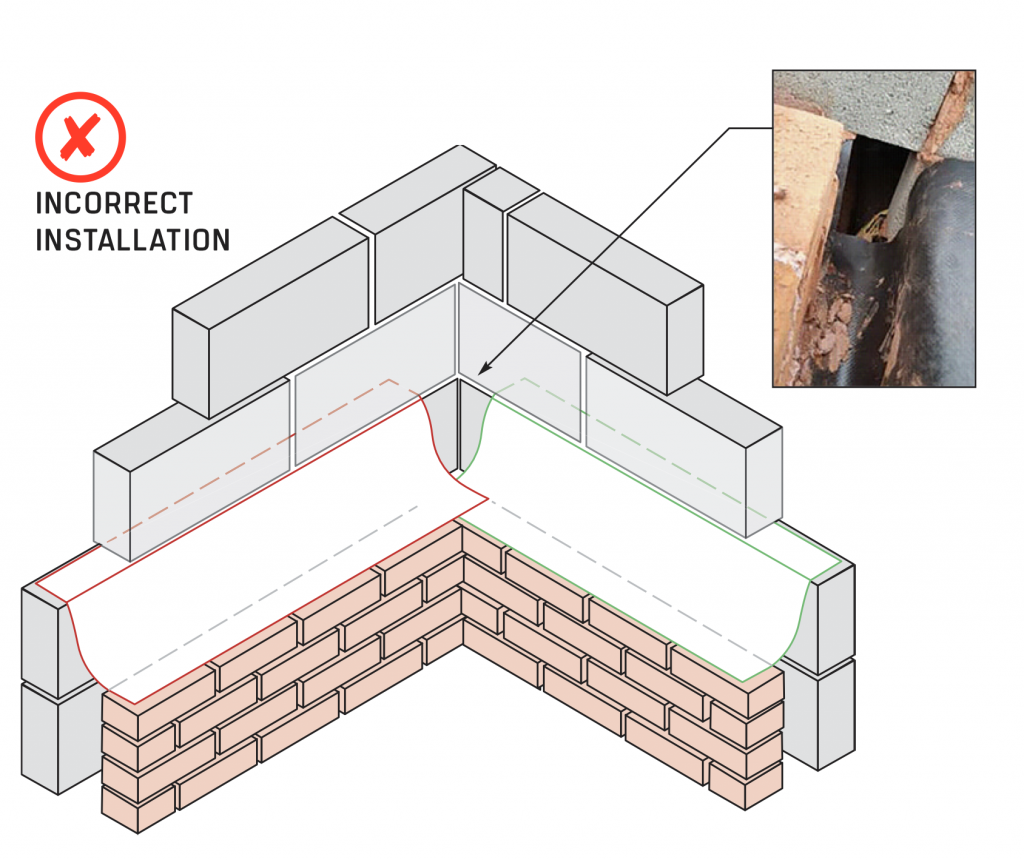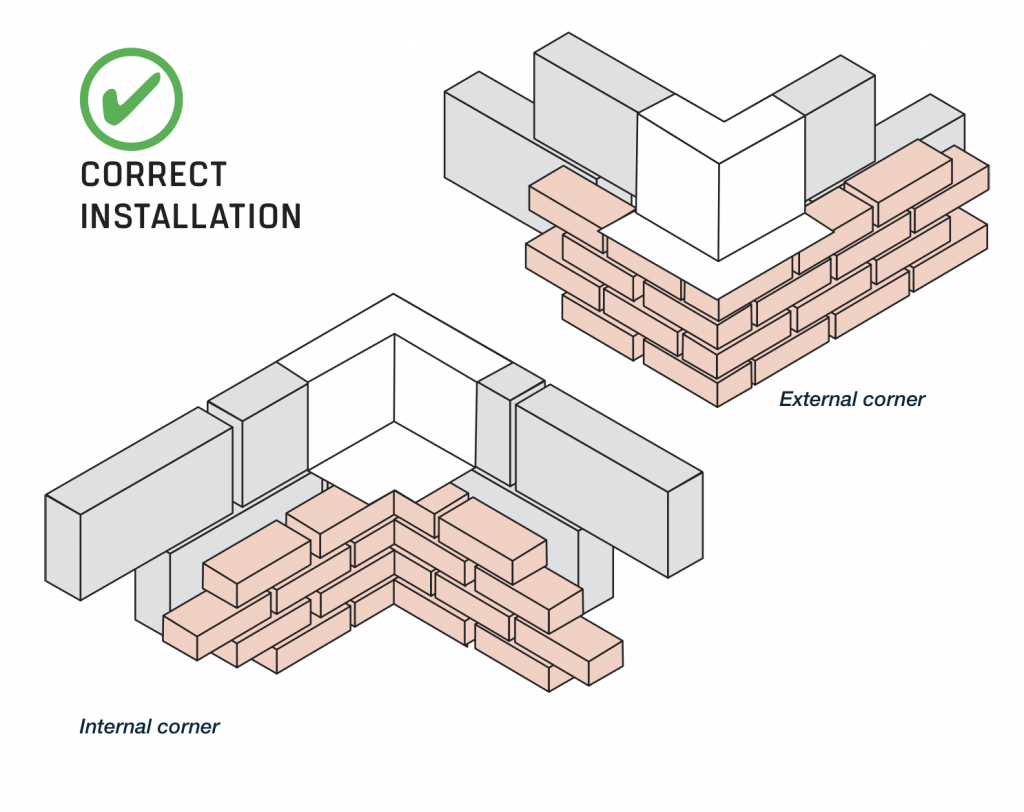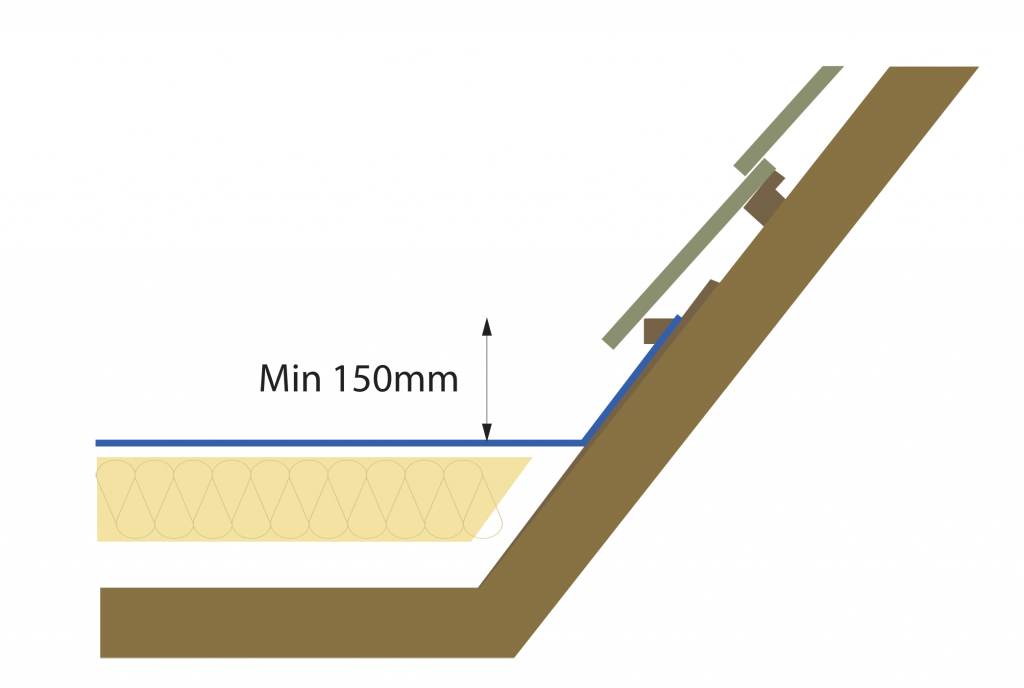With extreme weather and flooding becoming both more common and more severe because of climate change, it is crucially important to guard properties against the risk of water ingress
Cavity trays, including weep holes and stop ends, prevent the build-up of water within a cavity wall and allow the water to escape through the outer leaf.
This guidance is applicable to masonry cavity walls in buildings less than 18m in height.
In critical locations within low-rise cavity masonry walls, where the risk of water ingress is particularly high, the cavity tray detailing is complex and relies on a high level of workmanship, it is recommended that a proprietary cavity tray system is installed.
Figure 1 has been produced to give the photograph taken by one of our site surveyors some further context. In the photograph, you can see an attempt to form a cavity tray using a flexible type DPC around a corner. However, the end of each sheet could not be turned up at the corner intersection, resulting in a clear passage for moisture ingress to the cavity below. This is a common corner detail that many developers get wrong.


The construction of stepped cavity trays and cavity trays around corners relies on a high level of workmanship to install and work correctly.
As such, it is recommended that in low-rise cavity masonry walls a proprietary cavity tray system should be used for all stepped abutments or lower storey abutments and where cavity trays continue around corners.
By using a propriety cavity tray system, the risk associated with forming cavity trays in these areas is reduced.
This also meets the recommendations of BS8215 design and installation of damp-proof course in masonry construction section 6.7 which states: “Because changes of direction of a cavity tray are more complicated than joints and would involve complex bending and folding if fabricated on site, it is recommended that prefabricated corner units are used.”
The BS also reiterates the importance of ensuring the preformed trays are correctly sealed to the continuing trays.
The use of preformed cavity trays reduces the risk in these areas. However, it is still important that the cavity trays are the correct trays for the position and that the trays are positioned correctly in the wall with the bed joint raked out to allow installation of the flashing.
More construction tips and advice can be found online on the Premier Guarantee Resource Hub.
Claims learning – box gutters
The property discussed in this article is a period coach house which is believed to be some 100 years old, with conversion works carried out in about 2007. The property is a two-storey detached house with slate tiled roof sections and a glazed atrium roof that runs through the centre of the property. In addition to this, the tiled roofs and atrium are separated by two runs of flat/stepped valley gutter, which drain from back to front and down into lower secret box gutters at each side of the glazed front entrance.
The secret box gutters to each side of the atrium have been constructed with inadequate falls, with virtually no upstand to either side of the gutter. The outlets are inadequate to cope with the volume of water discharging from the adjacent roofs into the secret box gutters and therefore, under periods of heavy rainfall, the gutters flood up over the inadequate upstands and the water tracks into the property. The image to the left shows the lack of fall and ponding of the gutters.
During the investigation into the leaking roof, inspections showed very poor workmanship generally when the roof was recovered. In particular, the standard of workmanship in the vicinity of the secret gutter was extremely poor.
There have been a number of attempts to repair the secret box gutters as can be seen in the accompanying image, but fundamentally the roof needs to be stripped in the vicinity of the secret box gutters and new box gutters constructed with adequate upstands, falls and drainage outlets.
When the original secret box gutter was designed, it should have been regarded as a flat roof interface to pitched roof. The Premier Guarantee Technical Manual 7.10.9.1: Figure shows a typical detail. This would have given a minimum 150mm upstand to the box gutter.

Of drainage of flat roofs, section 7.10.5 of the Premier Guarantee Technical Manual states: “Drainage design should be based upon calculations in accordance with BS EN 12056 Part 3 given a design head of water (typically 30mm). Rain water outlet capacity should be taken from properly certificated information provided by manufacturers, and the resulting number and layout of outlets should allow for obstruction and drag due to any additional surface finishes, such as walkways.
“It is not generally necessary to provide separate box gutters where two planes of roofing intersect, or where a single plane falls to an abutment. In the latter case, there will be no fall between outlets, so consideration should be given to creating these in the structure or insulation. Box gutters are slow, difficult to construct and introduce unnecessary complexity. The need to maintain a fall in gutters and comply with the energy requirements of the Building Regulations may be difficult to achieve.”
How to choose a structural warranty provider
The latent defects market has increased significantly in recent years, with there now being more companies in the market than ever before. As such, it can be difficult to know where to look and what to look for
Structural warranty cover
Different structural and building warranty policies do not necessarily carry the same level of cover. Whilst some differences in cover may be subtle, others may be quite drastic, possibly leaving your buyers unprotected should something go wrong. There is also no consistency on the level of excess or financial limits.
Although the best way to thoroughly understand any insurance policy is to read it in full, that can often be very time-consuming. Therefore, we’ve thought of a few questions that could be useful to ask:
- What is the policy excess?
- Does the policy include a defects period?
- What is the financial limit for each property?
- Is there an overall policy limit?
- Is water ingress excluded from cover?
The insurer
More often than not, structural warranty companies will provide insurances policies that have been underwritten by insurance companies, rather than underwriting the policy themselves. This means that any claims on the policy will be paid by the insurer. Compared to the most common insurance policies, structural warranties last for 10 or 12 years, meaning it’s even more important to check the quality of the insurer and to ensure that they will be around for the entire duration of the policy. One way of doing this is to check who is insuring the policy and then to check their financial rating.
Risk management and technical support
Although you are purchasing insurance cover, it is worth bearing in mind that it is the warranty provider that you will be working with for the duration of the build. As such, it is good practice to understand how they operate in order to determine whether they’re the best fit for how you work on site. Some question you could ask is…
- Do they have clear technical standards?
- Do they employ their own surveyors?
- What technical support can they provide?
Customer service
Another important aspect of your structural warranty provider is the quality of customer service they provide; after all, you will be dealing with the customer service department of your chosen provider a lot over the duration of your build, as well as them issuing all your relevant certificates. So, what do you need to know?
- Will you have a dedicated account manager?
- How will you track and measure site performance?
- How quickly can you expect to get a response to your queries?
- Will you be provided with any homeowner feedback?
Level of experience
The level of a company’s experience is an important factor across all sectors and all industries, so why would the structural warranty industry be any different? To get a measure of how experienced a company is, you could consider asking the following questions:
- How long have they been providing structural warranties?
- Are they a member of the Consumer Code for Home Builders?
- Are they accepted by all major mortgage lenders?
Value
Rather than focusing just on monetary values, it is worth looking at value of your provider on the whole. Of course it’s vital to look after those all-important purse strings, but it’s also a must to consider the overall value from your chosen provider. By asking the above questions, and making sure you are satisfied with the answers, you should be able to better understand the value that your chosen building warranty provider will be able to contribute to your build.



